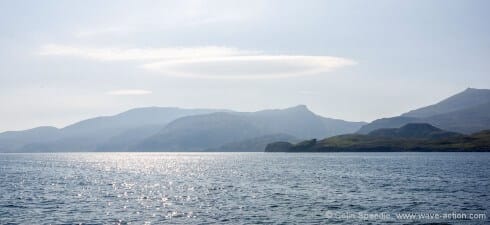
I’m beginning to suspect we may have magical powers. Every time we return to Scotland to conduct our annual basking shark survey the weather is, well, perfect.
It’s as if we brought the sunshine with us from Grenada, although, happily, without the trade winds. I think we should apply for a post as rain dancers in reverse—think of what that would do for the tourist economy!
Sailing with a purpose
Regular readers will know that that I’ve been engaged in marine conservation survey work for many years, and indeed had the great good fortune to meet Lou on one of my surveys. However, after nearly twenty years working at it my body told me it was time to slow down and go long distance cruising for a while. But, like an addiction, it keeps calling me back to continue our work, and hang the aches and pains.
It’s a risky business, though, as choosing the dates is tempting fate, a bit like playing ‘pin the tail on the donkey’ with a very uncertain outcome. Who knows what the weather might bring?
Being the west coast of Scotland it could be diabolical, with solid gales and sheets of rain for the whole spell. Instead we’ve had several years when the sun has shone (well, mostly) and the winds have been light, perfect for the line transect surveys and photo-identification of individuals that we conduct on behalf of the Shark Foundation as we seek to establish how the sharks use the area.
Perfect conditions mean long days, though, with early starts and late arrivals in the remote anchorages—you’ve got to seize the moment. But equally it also means that many of the most exquisite anchorages are tenable, so we make sure we have a magnificent backdrop as we ease off at the end of the day.
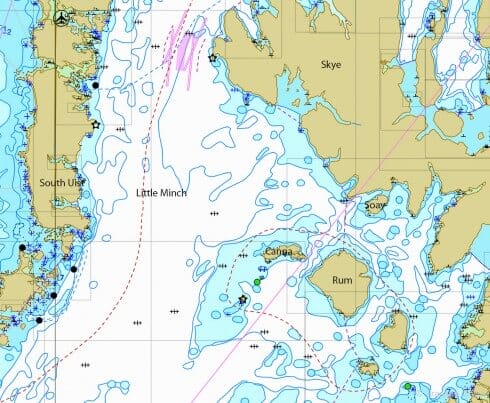
Some of the best ones need the tides to be right to suit entry and exit, such as the lovely little lagoon at Soay, that sits beneath the magnificent Cuillins of Skye.
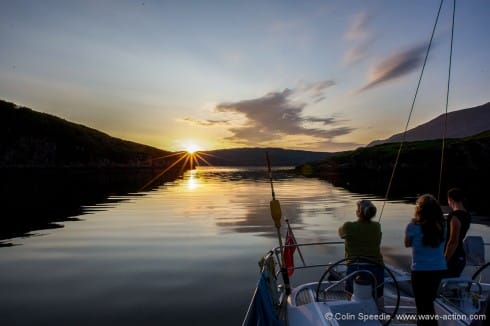
This is not just an anchorage for us, but almost a place of pilgrimage, as this was the island where the late author Gavin Maxwell had his shark factory, to process the sharks that he and his crew had killed.
Fortunately for the sharks, Maxwell was far from successful in his efforts to make his fortune, but he did record the story in a wonderful book Harpoon at a Venture, just re-published in a new edition with many additional photographs—required reading for all those who relish wild places and the usual tales of quixotic endeavor and wild characters that such places attract with their magnetic call of the wild.
Meeting old friends
It’s not just sharks that we’re looking for, although that is our primary goal. We also record and photograph whales and dolphins to help our friends and colleagues at the Sea Watch Foundation and the Hebridean Whale and Dolphin Trust.
Every year Sea Watch runs Britain’s National Whale and Dolphin Watch, a week where members of the public are asked to record and report their sightings from all around the UK, giving a snapshot of what’s out there. As this week coincides with our survey, we always join in, especially as the scientist in charge, Dr. Peter Evans, is an old friend who got me started in this madness many years ago.
In the summer of 1992 I found myself bumping across a very lumpy Little Minch in the ancient sailing trawler chartered for his survey on my first voyage as skipper. I was beginning to doubt his (and my own) sanity as the wind howled and the rain came down in torrents, and the volunteer crew slumped into seasickness and apathy.
I couldn’t for the life of me imagine we’d see anything at all in such conditions, and had all but given up when he came bowling down the deck with a grin a mile wide and shouted “Orcas—no doubt about it!” And there they were, approaching the boat, a huge bull with a 2 m (6.5 ft) high dorsal fin and a younger animal.
Now there’s something very purposeful about orcas, and I have to admit I felt a little apprehensive at their approach, but they altered course as they neared us and passed down our beam at around 50 m (55 yards) away. And I saw that the big bull had a distinctive notch at the base of his dorsal fin—I’d just met the legendary John Coe.
First sighted and named in the 1980s, he was already a fully grown dominant male, and was a regular feature of the west coast scene. Since then he has been recorded regularly in many places around Ireland and Wales as well, so he’s a real traveller.
And this year, for the first time since that day, I saw him again, out in the Minch west of Canna, in company with three others of his kind, his sabre like fin now leaning over slightly, both of us worn down with the passing of time but still out here living the life. It was like meeting an old friend after a long separation, and a moment to be savoured.
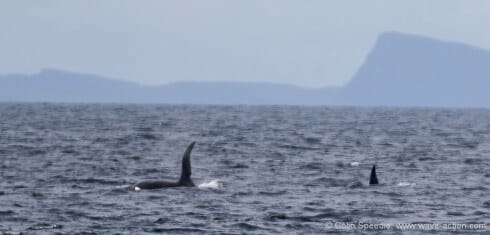
Real signs of life
Travelling back and forth across the Minch and the Sea of the Hebrides can be a lonely experience if you’re not interested in nature. But there is so much life out there if you look, which is why we are always so lucky with our sightings, as we watch systematically.
And it’s not just the larger, more charismatic species we see, as there is always a rich mandala of birds on display. This year the bird life out there was extraordinary, benefiting from the rich plankton soup that was flooding into these waters.
I have a particular soft spot for the stubby little fulmars that wheel around us, and who have often kept us company in the wildest conditions, providing a welcome diversion in sometimes trying times. Masters of the air, they glide around the boat making sudden instinctive swoops that never fail to please.
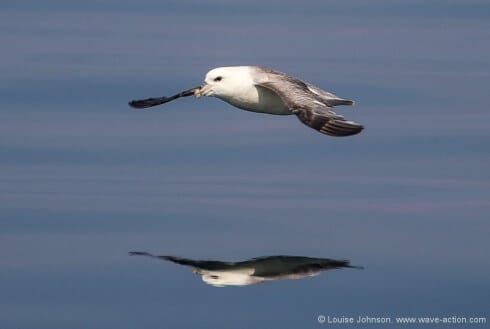
And it wasn’t just the birds profiting from the plankton, as basking sharks finally turned up in substantial numbers at last. After a slow start in our first week, the perfect weather conditions called them in. We found a big shoal, north of the island of Coll, one of the hotspot areas our previous research identified.
We always know when a big shoal is in the vicinity by the number of sharks we record breaching clear of the water; the more breaches, the bigger the shoal, we believe. The following morning we tracked down the shoal again, and recorded fourteen breaches, a record for us, amongst fifty sharks recorded, a number that equaled our second best day out here. Seemingly everywhere we looked we could see sharks, an extraordinary experience, especially when you consider that the biggest sharks can be over 11 m (36 ft) long!
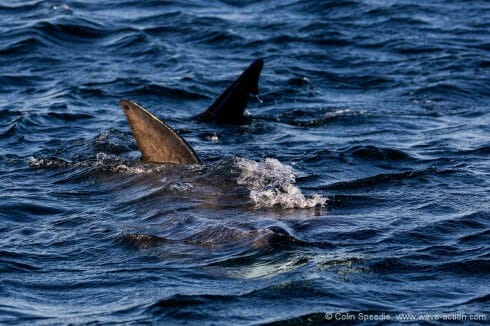
Hope for the future?
In a world where sometimes it seems that everything is going to hell, it can be hard to be optimistic. Knowledge isn’t always a benefit, often it can be a burden, and when you know the facts about the problems the marine world faces—overfishing, pollution, rising temperatures, to mention a few—that knowledge can be deeply depressing.
But after so many years conducting this type of work, I’ve learned to celebrate the little victories and embrace all that we see, perhaps as a shield against too much negativity. So you can imagine, I’m sure, how buoyed up we were to hear during this year’s survey that one of our favourite areas, the Small Isles, was to be designated a Marine Protected Area.
I and many, many others have long argued for this, and it was a delicious moment, and a source of quiet satisfaction for me on behalf of the hundreds of volunteers who have helped us towards that end over the years. Hopefully that will help to ensure that future generations will also be able to enjoy all that we have been lucky enough to see in our time spent in this lovely place.
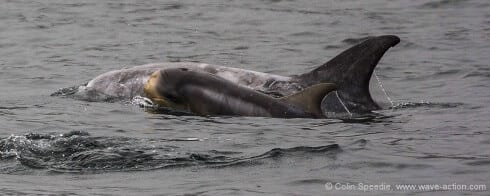
And almost in affirmation of that hope, the next day we encountered a pod of twenty Risso’s dolphins, complete with many mother and calf pairs, some of which (like the one above) have been recorded and named before.
Risso’s are my favourite dolphins—slow, graceful, dignified and shy, with the older animals turning an almost ghostly white—they are wonderful to watch. Generally averse to the presence of boats, they require very careful, sensitive boat handling to avoid scaring them off, so we were on our best behavior.
To our amazement the pod approached us and then slipped around our stern, giving us the ultimate opportunity to absorb their presence. With so many youngsters amongst them we all felt a powerful, positive sense that things aren’t all bad out here, that nature is resilient, and that all of our puny efforts as marine conservationists might just have a purpose. And that might be our ultimate, extraordinary reward.


Hey! Colin,
Is your boat on AIS? I’d follow if so. I can’t afford AIS but have started using mAIS which is free. Fine when in mobile signal and an embedded map in my homepage shows friends and family where I am. See website link above.
Out of interest I got these charts this year for the West Coast http://www.antarescharts.co.uk/
I’ve met Bob who creates them and just a thought, but maybe some of your marine wildlife work could be integrated into his work. I’ve yet to use the out of the way chartlets for some good anchorages.
And yes, it has been glorious here. I put two wooden bungs in my cockpit drains the other week, as the teak sole was too hot to stand on. In fact I filled my small cockpit to about 9″ depth and had a wee bath in the Scottish sun. Happy days. It sounds as though you’ve enjoyed the West.
It’s just been the Clyde for me this year, but that has been bonny too. Very much enjoying my electric propulsion. It makes wildlife come alive in the peace. Now done 1,000 miles total. Nothing compared to you folks, but special anyhow.
John R.
Hi John
our own boat is on AIS, but not the charter boat we use for the surveys.
And in my next piece there will be a brief review on Antares charts, as we used them for the first time this year. If you don’t mind waiting I think you’ll like it!
What an amazing summer – I’ll bet you put a lot of those 1000 miles in through lack of wind….
Best wishes
Colin
What a beautiful account! “In a world where sometimes it seems that everything is going to hell, it can be hard to be optimistic”, you say. People who look at the world around them like you do help restore a bit of optimism. With this I refer not just to this article, but to your reporting in general. Thank you so much!
Pascal
Hi Pascal
and thank you so much for saying so – brightened my day up no end.
I’ll try to keep it coming!
Kind regards
Colin
Thanks, I needed that, Colin. Have been listening to too much news lately. we had a remarkable experience in Clew Bay as hundreds of bottlenose dolphins came in and swam with us for about an hour. We got some great photos.
BTW, we call those clouds that spin off mountain tops lenticular. (Altocumulus lenticularis) They spin off Croagh Patrick, the Holy mountain with some regularity.
Hi Daria
glad you liked it.
The west of Ireland is great for dolphins, especially the big pod in the Shannon estuary – maybe the ones you saw were some of them out on a ramble? The Moray Firth (Scotland) population now roam as far South as the Forth I’m told.
I’ve heard the term lenticular before, but not being the resident cloud expert didn’t quote it – Lou has now corrected me!
I love any and all natural effects of that nature though – and as sailors we’re lucky to get to see more examples of them than most.
Best wishes
Colin
Wonderfully written as usual Colin. I could feel the experience you shared. Thank you. And, thanks for sharing the location of one of your “secret spots”.
Jim
Hi Jim
one secret spot a year, Jim – and only for you, of course…
See my next piece for another example though.
Two a year! I must be slipping…
Best wishes
Colin
Thank you for an interesting article and lovely photos. I do hope the Marine Protection Area in the Small Isles has come about with local input and has local support. I understand this has not always been the case when conservationalists have their say in Scotland?
Ian Mitchell is maybe not a popular author with the organizations for whom you work, however his book “Isles of the West” is worth a read. While based on his 1996 sail through the islands, the fifth edition published 2012 has much recent information including the 2004 postscript about marine national parks.
http://www.amazon.co.uk/s/ref=nb_sb_noss_1?url=search-alias%3Daps&field-keywords=ian%20mitchell%20isles%20of%20the%20west&sprefix=ian+mitchell+%2Caps
Hi Hans-Jakob
I read both of Ian’s books when they came out, and enjoyed them both. There was much to learn from them, and although I didn’t agree with everything he wrote there were many lessons to be learned from his account.
That was a long time ago, though, and the debate is far more open these days. Indeed there always were two sides to the argument, in any case. The latest MPA’s were largely arrived at through open consultation of all parties, and so should attain wide public support.
Incidentally, as a conservationist, I’d like to see fish stocks rebound, offering good food and greater employment in fishing communities – which would benefit us all in the long run.
Kind regards
Colin
no doubt this is an interesting post…just think it is somewhat off-message for aac
richard s. in tampa bay
Hi Richard,
Your comment brings up an interesting editorial point. You see we differ from magazines in that we don’t try to stick with a “message” that is dictated by an editor, or sadly these days by a publisher. Rather the writers write about their experiences and passions without editorial interference. In my opinion this leads to a much more authentic type of content that allows the reader to actually get to know the writer.
In my case, you will note that I write about photography from time to time. A subject that could be construed as off message.
In Colin’s case his conservation work is a huge part of who he is and his interaction with, and love for, the sea. Colin without marine conservation would be a pale shadow of the great marine writer he is.
By the way, I can tell you with my publisher hat on that Colin’s conservation posts always receive good traffic too!
Hi Colin,
I have distressing little knowledge about marine mammals, but even so my sightings of them are among the most important memories and emotions I have about my voyages.
Your article brought back a lot of that and the paragraph about John Coe caused a prickle behind my eyes, not an easy thing to do to this old curmudgeon.
Hi John
I’m glad that we have the freedom to cover subjects outside the usual sailing sphere, as it always seems to me that there’s far more to sailing (as a way of life) than juts the mechanics of it.
Which doesn’t (of course) mean that I don’t like reading or writing about sailing itself – and I hope Richard will enjoy my next post, which is much more focused on cruising matters.
Best wishes
Colin
Hei Colin
Thank you for that really beautilfull post!
Hi Simon
and thank you for that kind comment.
Best wishes
Colin
Dear Richard,
I would venture that sailing is not the primary interest for many, likely most, of us although those of us who participate regularly take it quite seriously. In the final analysis sailing (and the boats we sail on) definitely holds a never ending fascination as transportation and home and an interface with Mother Nature and all she has to offer but is often the means by which we pursue other goals. Colin’s article is a lovely example of this in addition to its being superbly written (“stubby little fulmars that wheel around us” captures this bird in flight perfectly).
So, for me, the article is very much on message.
My best, Dick Stevenson, s/v Alchemy
Ooch, seems I have chosen my wording with less sense than I should have (my comment a week ago. It was not my intention to down-talk Colin’s essays, which I enjoy as much as other users of this site. My most sincere apologies if I have caused offence.
I do not question the good intention behind nature reserves, conservation zones and the like. Voyagers in small boats may want to consider possible negative implications – maybe more apparent in high latitudes where there are few or no local pressure groups.
Please bear with me for a few illustrations: Northbound along Norwegian W coast Tungevågen used to be the first viable anchorage after rounding the notorious Statlandet – our local Cape Wrath. The bay is no longer accessible to yachts after having been made a nature reserve. In Spitsbergen access to shore in anchorages such as Ebeltofthamna , Virgohamna and Ytre Norskøya is limited. Restrictions on land based activities (eg beach fires) are enforced throughout the island group. In Bear Island boats above 40’ are not allowed within 1 nm of shore in the Reserve area. In Jan Mayen anchoring is permitted only in a couple of designated places, landing likewise. Climbing Mt Beerenberg is no longer a viable proposition.
Had Bill Tillman done his arctic expeditions today he would probably spend as much time battling authorities as battling the elements. In his voyages to Spitsbergen and Jan Mayen he broke every rule in the current book. But I do believe Mr Tillmans’ carbon foot print would meet the approval of even the most die-hard environmentalist.
I can however see that this is way off-topic and better discussed elsewhere!
Hi Hans-Jakob
Speaking personally I had no problem whatsoever with your original comment, and indeed welcomed it – in order to make conservation areas work we badly need dialogue between all parties, and I’m all in favour of it.
I share your concerns about some designations in remote areas, and I think you’re entirely right that in areas where there are few voices, it may be easier to push through stronger designations than we’d like to see – once again, let’s engage with the process and let our voices be heard.
And I don’t doubt that Bill Tilman would have despaired at the changes – he was, after all, a true free spirit and lover of wild places. But equally, he probably couldn’t have conceived of how many people would follow his path either at sea or in the mountains, and I guess that’s where the current debate is centred – how can we preserve the wild places, so that they remain wild and unspoiled? Look at the environmental problems in the Himalaya due to unrestricted and commercial access – I wonder what he would have made of that.
Best wishes
Colin
Such a lovely post – thank you, Colin! My family and I just returned from a trip to the Bay of Fundy. We had the amazing fortune of sailing into an area with many right whales, minkes, porpoise, sunfish and others. I’m also fairly certain we had a basking shark following in our wake for a bit as well! While the sailing itself is always an adventure, what really makes it great is how close we come to the natural world around us. Our children will never forget the experience of seeing right whales from the bow of our boat or watching minkes breach within shouting distance. With this experience so close in my mind, reading your post brought me back to it immediately. I love reading your wildlife research posts and hope for more to come.
Thanks again,
Morgan
Hi Morgan
Being able to show wildlife to the next generations is such a rewarding thing, and I’ve also been lucky enough to do that with my children, too. Such moments form an unbreakable bond between the generations.
Hopefully we’ll get to see the wonders of the Bay of Fundy next year – judging by your comment and Phyllis’ latest post it sounds unmisssable, and just the sort of place we’ll love.
And thank you so much for your kind comment – I’ll do my best to keep them coming.
Best wishes
Colin
Colin,
“Being able to show wildlife to the next generations is such a rewarding thing”
I could not agree more and so well put. Both my Grandfather’s were naturalists. My first proper boat trip was from Rhu to Port Ellen on my Uncle’s boat when I was 16. My maternal Grandfather lived on Islay and indeed wrote a few bird books about the island. He was a friend of Sir Peter Scott’s and they counted the geese there too. I learned much and experienced such joys because of these connections.
A memory that is burned into my mind is peeking over the edge of a cliff on The Oa, to see an eagle on its eyrie. but 15ft down the cliff – and being able to watch it take off and soar.
John R.